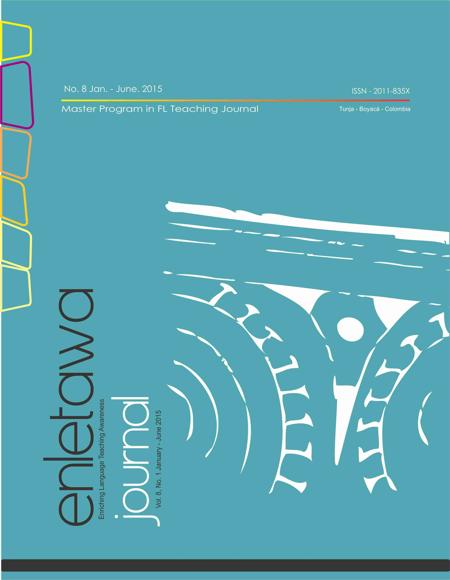Restory a Resilience Experience After a Natural Disaster

Resumen
As an attempt to describe a resilience process after a landslide through narratives, this research study aims at analyzing, interpreting and describing how Chevano tenth graders restory their resilience experience after a natural disaster in their hometown. This inquiry was carried out with students at López Quevedo School in Jericó - Boyacá, Colombia. The information was gathered through students’
narratives, students’ interviews, and researcher’s field notes. Narratives made part of a pedagogical intervention to explore student’s ways of coping with tragedy, and they allow students’ voices to be expressed. It was revealed that students needed to share their stories to achieve a process of
resilience but it was important to give participants the time to start that process. Moreover, they needed to be involved in a social context they felt they made part of as well as in a routine in which they could set apart the negative thoughts and feelings of sadness from their present experiences.
Citas
- Bailey, J. (2008). First steps in qualitative data analysis: transcribing. Family Practice, 25(2), 127-131.
- Clandinin, D. J., & Connelly, F. M. (1988). Studying teachers’ knowledge of classrooms: Collaborative research, ethics and the negotiation of narrative. The Journal of Educational Thought, 22
- (2A), 269-282.
- Clandinin, D. Jean & Connelly, F. Michael (1995). Educational Researcher: Stories of experience and narrative research 19, No 5 Retrieved from: http://www.jstor.org/stable/1176100. (Accessed: 06/09/2011)
- Clandinin, D. Jean & Connelly, F. Michael (2000). Narrative inquiry: Experience and story in qualitative research. San Francisco, Ca.:Jossey-Bass
- Clandinin, D. J., & Connelly, F. M. (2013). Narrative and story in practice and research. In D. Schon (Ed.), The Reflective turn: Case studies of reflective practice. New York: Teachers College Press.
- Denning, S. (2002). Using stories to spark organizational change. Systems Thinker, 13, 2-6.
- Denzin, N.K. and Lincoln, Y.S. (2000) (Eds.) Handbook of qualitative research (2nd ed.) California: Sage.
- Eccles, J. S., & Roeser, R. W. (1999). School and community influences on human development. In M. H. Bornstein & M. E.
- Lamb (Eds.), Developmental psychology: An advanced textbook (4th
- ed., pp. 503-554). Mahwah, NJ:Lawrence Erlbaum Associates.
- Elbaz-Luwisch, F. (2002). Writing as inquiry: Storying the teach- ing self in writing workshops. Curriculum Inquiry, 32(4), 403-428.
- Elbaz-Luwisch, F. (2005).Teachers’ voices: Storytelling & possibilities. Greenwich, CT: Information Age.
- Ezzy, D. (1998) Theorizing narrative identity: symbolic interactionism and herme neutics. The Sociological Quarterly, 39(2), 239-263.
- Ezzy, D. (2002). Qualitative analysis: Practice and innovation. Crows Nest, NSW: Allen & Unwin.
- Gudmundsdottir, S. (2001).Narrative research on school practice.In V.
- Richardson (Ed.), Fourth handbook for research on teaching (pp. 226-240). New York: MacMillan.
- Josselson, Ruthellen (Ed.) (1996). Ethics and process in the narrative studies of lives (Vol. 4). London: Sage.
- Henderson, N., & Milsltein, M. (1996). Resiliency in schools: Making it happen for students and educators. Thousand Oaks, CA: Corwin Press.
- Kahn, R. L., & Cannell, C. F. (1957). The dynamics of interviewing; theory, technique, and cases. Oxford: John Wiley & Sons.
- Kotliarenco, M. A., Cáceres, I., & Fontecilla, M. (1997). Estado de arte en resiliencia. Washington eD. CDC: Organización Panamericana de la salud.
- La Greca, A; Apastaff.(2008). Children and Trauma: American Psychological Association [APA], p.4. Retrieved from: http://www.apa.org/pi/families/resources/children-trauma-update.aspx
- Luthar, S. S. (2006). Resilience in development: A synthesis of research across five decades. In D. Cicchetti& D. J. Cohen (Eds.), Developmental Psychopathology: Risk, disorder, and adaptation (pp. 740-795). New York: Wiley.
- Masten, A. S., & Obradovi, J. (2006). Competence and resilience in
- development. Annals of the New York Academy of Sciences, 1094(1), 13-27.
- McLean, K. C., Pasupathi, M., & Pals, J. L. (2007). Selves creating stories creating selves: A process model of selfdevelopment. Personality and Social Psychology Review, 11(3), 262-278.
- Pianta, R. C. (2006). Schools, schooling, and developmental psychopathology. In D. Ciccheti& D. J. Cohen (Eds.), Developmental psychopathology: 1. Theory and method (2nd ed., pp. 494-529). Hoboken, NJ: Wiley.
- Richards, L. (2005). Handling qualitative data: a practical guide. London: Sage Publications.
- Riessman CK. (2000). Analysis of personal narratives, in JF Gubrium and JA. Holstein (Eds), Handbook of editing: Sage Publications.
- Riessman, C. (2007). Narrative methods in the human sciences. New York: Sage.
- Shope, J. H. (2006). “You can’t cross a river without getting wet”: A feminist standpoint on the dilemmas of cross-cultural research. Qualitative Inquiry,12(1), 163-184.
- Smith, D. (2001). Interior architecture as a storied life: Narrative-research and the built environment. IDEA 1(2).Retrieved
- from: http://eprints.qut.edu.au
- Tugade, M. M., & Fredrickson, B. L. (2004). Resilient individuals use positive emotions to bounce back from negative emotional experiences. Journal of personality and social psychology, 86(2), 320.
- Vygotsky, L. S. (1978). Mind in society: The development of higher psychological processes. Cambridge, MA: Harvard University Press.